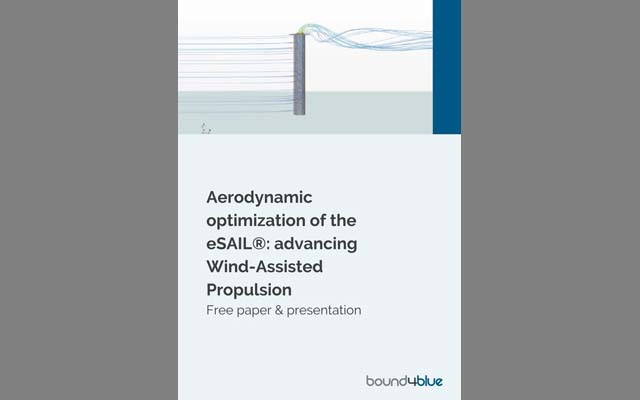Spanish company bound4blue says it is continuing to develop its wind-assisted propulsion system, the eSAIL, and has published a paper giving details of its current progress.
Developed to reduce fuel consumption and emissions, the eSAIL uses suction sail technology, originally pioneered by the Cousteau Foundation’s TurboVoile. The paper highlights how bound4blue’s aerodynamics team has fine-tuned its tools to further optimise the eSAIL for real-world applications, making significant strides toward the green energy transition in shipping.
The company now expects accelerated technical due diligence processes though working with customers, paving the way for a simpler system roll-out. This will help shipowners, removing the burden of individual quality validation, speeding up access to eSAIL benefits including reduced fuel consumption and emissions, lower Opex, and simplified compliance with regulatory demands.
The foundation of the eSAIL optimisation process lies in Computational Fluid Dynamics (CFD) simulations. Initially, these simulations were calibrated against experimental TurboVoile data, the only available experimental dataset for suction sails. This provided a reliable starting point for bound4blue to validate its tools and proceed with further design optimisation.
Once CFD tools were validated, bound4blue embarked on a comprehensive exploration of the suction sail’s design space. This included 2D parametric studies to identify the most promising geometries, followed by more intricate 3D simulations. These simulations examined various factors that influence performance, such as fan characteristics, winglet effects, suction area porosity, and local disturbances in the suction area. Before fully trusting the CFD results, a wind tunnel campaign was conducted to validate the findings. The goals were twofold: first, to confirm the CFD results, and second, to further refine the calibration of bound4blue’s tools. The wind tunnel tests showed excellent correlation in pressure and force data, giving the team high confidence in its ability to predict real-world performance.
The culmination of the research was a 20% improvement in the lift-to-power ratio compared to TurboVoile, with a maximum lift coefficient of 8.3. These improvements make the eSAIL a more efficient solution for wind-assisted propulsion, allowing for greater fuel savings and emissions reductions.
With a foundation of validated CFD simulations, bound4blue has now moved toward simulating more complex, real-world conditions. These include factors such as the atmospheric boundary layer, sail-to-sail interaction, and ship-to-sail interaction. By incorporating real ship data, bound4blue can fine-tune the eSAIL’s autonomous control algorithm for each installation, ensuring maximum fuel and emissions savings.
The paper can be downloaded here.



